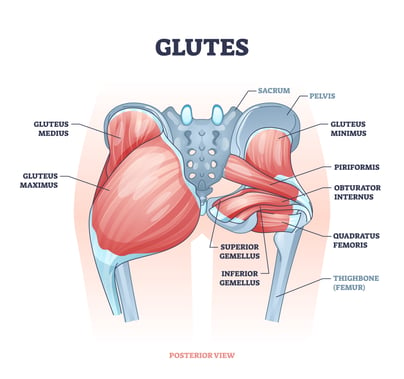In the age of social media, it’s easy to get overwhelmed by the amount of information that is thrown at you each day. Put aside what you know about glute training for the time being and let's focus on two major keys to making progress in a specific area of the body:
- The function of the muscles.
- The exercises that target the muscle the best.
In part 1 of this blog, you will learn the anatomy and function of the glutes. In part 2 I will discuss proper programming to achieve the best results.
 The Gluteal Muscles
The Gluteal Muscles
The gluteal muscles are a group of four muscles: the glute maximus, the glute medius, the glute minimus, and the tensor fasciae latae. Although all animals have glute muscles, large, developed glute muscles are a characteristic of humans that has adapted from a two-legged locomotion. The primary function of the glute muscles is to abduct (to move away from the midline) and extend (kick back) the thigh at the hip joint. This group of muscles also assists in adduction (to move toward the midline), and external and internal rotation.
Glute Minimus
Starting with the smallest of the muscles, the glute minimus is the deepest of the four muscles. It acts in synergy with the glute medius to abduct and internally rotate the thigh at the hip joint. The glute minimus also helps stabilize the pelvis.
Glute Medius
The glute medius is deep to the glute maximus, but superficial to the glute minimus. The glute medius can be seen as a superficial muscle. Therefore, it is important to work the muscle actions of the medius to build well-rounded glute muscles. The glute medius abducts and internally rotates the thigh at the hip joint. It also stabilizes the pelvis and trunk during gait.
Glute Maximus
The glute max is the largest and most superficial of the glute muscles. This is the main muscle that provides the majority of the shape. Its function is to extend and abduct the thigh at the hip joint. The glute max also assists external rotation and adduction.
Tensor Fasciae Latae
The tensor fasciae latae is a fusiform muscle and is located on the anterolateral aspect of the thigh. It has a similar function to the glute medius, in that it abducts the thigh at the hip. It also plays a role in externally rotating the lower leg at the knee. Because it connects to the knee and hip joint, it assists in stabilizing the knee and hip.
Looking Ahead
Now that we have looked at what muscles we will be training, and what their functions are, we can choose exercises that specifically target those specific muscle actions. Our movements will primarily be ones that extend and abduct the thigh at the hip. In part 2 I will list the NIFS trainers’ favorite glute exercises, as well as how to organize them in your training for the best results.
This blog was written by Evan James, NIFS Exercise Physiologist EP-C, Health Fitness Instructor, and Personal Trainer. To learn more about the NIFS bloggers, click here.

